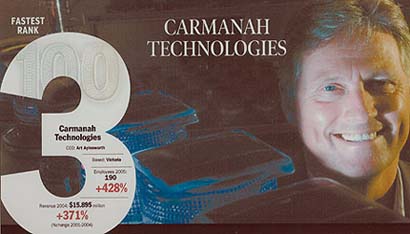Ready to turn on the juice…
Technology: Victoria solar lighting firm’s revenues have soared 371% since 2001, has eye on solar power-generation market.
 |
|
| Carmanah Technologies CEO Art Aylesworth says that, following the acquisition of Soltek, the company will likely begin providing solar energy generators for users in remote locations. Photo Credit: Nic Hume / Special to the Vancouver Sun. |
Victoria’s Carmanah Technologies – a growth powerhouse in the LED solar lighting market in Canada and worldwide – is poised to further expand its product line by entering the power generation market.
And that’s with the intent of continuing Carmanah’s impressive revenue growth, in which the company, ranked third in BusinessBC’s Fast 50, drove up 2004 revenues by 72 per cent. Carmanah’s revenue has grown 371 per cent since 2001 to $15.9 million.
Best known for the more than 100,000 solar-powered lighting systems installed at airports on roadways, on buoys and docks and in bush shelters in 110 countries, Carmanah recently laid out $12 million in cash and shares to buy Victoria’s Soltek Powersource Ltd.
Now Carmanah – armed with Soltek’s expertise and its own eagerly sought technology – intends to expand to offer integrated solar systems.
Probably the first area that Carmanah will enter will be a direct offshoot of the company’s present products, ones that integrate high efficiency solar generation of electricity with LED lighting.
The company will take its integrated lights and instead of mounting an LED on them it will replace that with an output plug.
“I call that a solar engine,” Carmanah CEO Art Aylesworth said. “It would be a power source that could run something quite simple to something quite big, depending on the size of the engine.”
One example of a potential customer, said Aylesworth, might be a fuel-industry well site, off the power grid, that wants to run three or four pieces of monitoring equipment 24 hours a day.
“We can say, ‘don’t go and design a system yourself. Buy this off-the-shelf from us and it’s ready to go,’ ” Aylesworth said.
A second move would be to expand Carmanah’s lighting products from mainly warning lights and transit shelter illumination to providing LED lighting for large areas that have no easy access to power.
Thirdly Carmanah wants to move into the provision of home and recreational property electricity, where owners on the power grid would draw power during periods of high usage in their homes and then put power back into the grid, from their solar units, when they’re in a low usage period.
“We predict that in 10 years the cost per watt of solar will be approximately a third of what is now, while the cost of traditional electricity will be at least double,” Aylesworth said. “The economics are going to swing hard and they’re already coming close because where they have government subsidies now the math holds up.”
Right now, Aylesworth said, people who want to be independent by adding solar power to their homes must call on somebody who comes up with a unique installation for their home.
“So you get Bob’s Roofing and Solar and Bob comes up with an answer,” Aylesworth said. “And you’d look Bob in the eye and wonder if Bob can do this. He might be perfect and he might not.”
Carmanah’s selling point on this will be that it won’t be reinventing the technology each time it has a new installation. It will develop prototypes and then packages that can, when fitted together, meet any need.
Along with the new ventures, Carmanah intends to expand its and U.S. Coast Guards that use the lights because they offer good lighting and require almost no maintenance. Carmanah is also expanding into the boat-and-dock-owner market.
Aviation lighting, where its main customers are military and defence buyers who want to light up airfields inexpensively and in places where power is not readily available. As well, it’s moving into the area of civilian airports.
Transit lighting, where the customers, ultimately, are the local transit authorities, but the sales are usually through advertising firms that provide the shelters free to municipalities and also offer them a percentage of the advertising revenue.
Carmanah’s customers range from Los Angeles International Airport to the Chicago Regional Transportation Authority to the Port of London to Baghdad International Airport in Iraq.
The company’s technology was developed directly as the result of a sailing trip to Fiji by Carmanah’s a couple of mornings when, after they’d been at anchor a for two or three days the anchor light drew the battery down and Dave couldn’t start the sailboat’s engine.”
Research on that began in 1994 and Carmanah was incorporated as a solar lighting company in 1996.
Carmanah’s incredible pace of revenue growth, at about 69% a year, may begin to slip slightly now that the company is maturing, Aylesworth said.
“But even if we add 50 per cent then, good grief, next year we’ll be at $55 or $60 million and I would call that enough,” Aylesworth said.
“I think Carmanah will continue to grow hard and fast, though, because we’re a well-positioned company with lots of infrastructure in place in a market that’s exploding.”
The next immediate big thing for the company, said Aylesworth, is to expand its operations from Victoria. It already has presences in Calgary and Toronto and London, England and will soon be adding California and New jersey.
“Next we want to figure out how we work through Southeast Asia and what we do about China. We will somehow be involved in China whether we own a plant there that does part of our work or that we have a tight joint venture over there.”